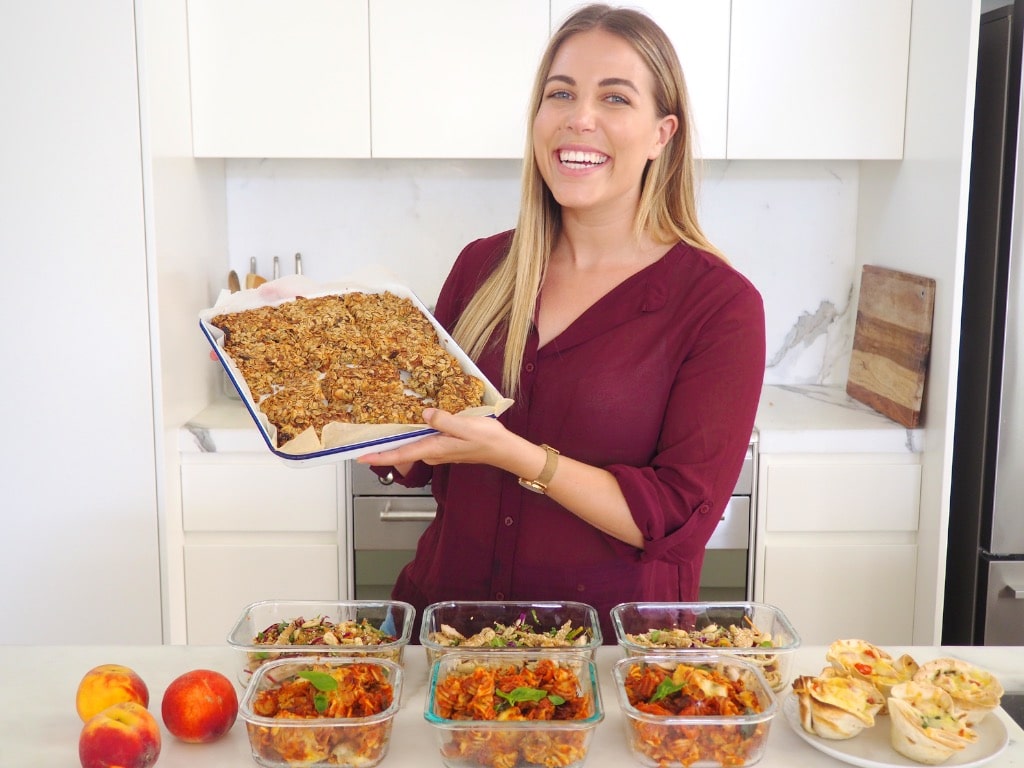So, what exactly is meal planning? And what is the difference to a meal plan?
They’re two things that sound the same…
But in actual fact, they’re chalk and cheese. Cheese being a magical thing that I love and chalk being, well, chalk.
Chances are, you’ve heard of a meal plan. Everywhere you look, there are fitness influencers and PTs spruiking meal programs that promise to give you shredded abs in six weeks. It probably won’t surprise you to hear that this is the one I’m not a fan of.
On the flipside, meal planning is an extremely valuable tool for your weekly routine, that can actually help you save money, eat healthier and improve your relationship with food. Consider it as a loose map of what you will eat throughout the week.
Read on to learn the important difference between meal plans and meal planning, plus how you can incorporate the latter into your weekly routine.
What is a meal plan?
You can dress it up however you like, but a meal plan is simply a diet in disguise.
It’s a program that tells you exactly what to eat and when to eat it. Some people believe that meal plans are less extreme than traditional diets, because they don’t always involve counting calories or cutting out certain foods.
But truth is, they can actually be even more restrictive because you have to stick to a plan to the letter, rather than just eat within certain guidelines.
The biggest problem with meal plans is that they’re completely inflexible. They often require rigorous planning and organisation which can suck up a lot of your time and mental energy.
If you eat one meal that’s not on your plan, it can lead to feelings of guilt and falling completely ‘off track.’ Oh, and you can pretty much say “seeya!’” to eating out or having a social life.
It can also be difficult to adjust meal plans to your personal preferences. Sometimes, you just really CBF eating a chicken stir-fry for the 4th night in a row, but your meal plan is telling you it’s their way or the highway.
The scariest thing about meal plans is that many of the PTs or online health coaches that give them to their clients have zero qualifications in nutrition. As a result, they often dish out one-size-fits-all meal plans that are highly restrictive and aren’t tailored to your specific needs and preferences.
If you have been on a meal plan your whole life, and are not quite ready yet to let go, I’ve got something for you.
I’ve put together THE LAST MEAL PLAN YOU’LL EVER NEED and you can download it here for FREE.
*hint* – It may not be exactly what you think it is…but I do hope you like it.
Oh, and you’ll never have to diet again. Hurray!
What is meal planning?
On the flipside, meal planning is a tool you can use to make your life SO much easier.
By loosely mapping out what meals you’re going to have throughout the week, you can ensure you always eat healthily, even when life is crazy.
This will save you loads of time and money, as you’re far less likely to resort to grabbing takeaway or eating out. This means that the meals you do eat out actually feel like more of a special occasion.
Meal planning also helps preserve your mental energy, as you won’t constantly be thinking (or obsessing!) about what you’re going to eat.
Because you’re creating them yourself, they’re also super flexible. You can look at what you’ve got on for the week and adjust your plan accordingly, which is not the case with meal plans.
Say you’ve got a huge week of running between meetings, you can ensure you’ve got enough snacks to keep you going. Or if you’ve got a few social events on at night, you’ll know not to bother prepping dinners for the week.
It allows you to eat foods you actually enjoy, but also to be proactive in making choices that are going to nourish and fuel your body.
My top tips for meal planning
Want to give it a shot? Great! Here are my 6 top tips to get started.
Step 1. Set aside time for planning
Have a designated time each week where you plan out your meals for the week ahead. I recommend scheduling this into your diary like you would any other appointment. Many people choose to do their meal planning on a Sunday, because that’s when they have time to hit the grocery shop and do a food prep, if that’s their thing.
By the way, when you plan and prep your meals with my app Back to Basics, you can order your groceries direct from the recipes in the app and get them delivered to your home. Bye-bye last-minute grocery runs and getting distracted in the chocolate aisle.
Make sure you check what you’ve got on for the week and plan your meals accordingly. If you’ve got social events on most nights of the week, there’s probably no point cooking up a huge batch of meals for dinner (unless you’re going to freeze it!)
Step 2. Do what works for YOU
It’s easy to look at all the #mealprep Instagram pics of perfectly packed Tupperware containers and feel like that’s the only way to meal plan. If that approach works for you, then great!
Many people find they save time and money cooking their meals in bulk. But here’s the thing: that’s not the only way to do it. If you’re someone who gets bored easily, or likes to cook their meals fresh, it’s totally fine to just have a rough idea of what you’re going to eat and buy your ingredients on the day.
And if the whole meal planning thing is just not for you, forget about it. The biggest health advice I can ever give you is to take on advice that suits you and leave the rest.

Step 3. Cater to your own tastes
The beautiful thing about doing your own meal planning is that you can fill your weekly menu with foods YOU love. Don’t like Brussel sprouts? Don’t eat ‘em! Obsessed with Buddha bowls right now?
Plan to do a few variations of that throughout the week! However, that’s not to say that you should eat pizza for every meal for a week.
Variety is the spice of life and it’s important to ensure you’re getting a good range of vitamins and minerals through your food. It’s also important to think about how certain foods make you feel when you’re doing your meal planning. For example, if heavy carbs put you sleep, you may want to swap them out for slow-releasing ones for your work lunches.
Step 4. Stay flexible
While I’m all for being organised I don’t recommend prepping your breakfast, lunch, dinner and snacks every day of the week. Food is meant to be fun and you’ve got to give yourself some wriggle room for spur-of-the-moment decisions.
I recommend leaving at least a couple of meals free per week, so you can have that impromptu lunch catch up with a friend, or spontaneous lunch catch-up. Better yet, cook up meals that you can freeze, so it doesn’t matter if you eat them right away!
Step 5. Get Back to Basics
Want a little bit of extra help with meal planning? But without dodgy or confusing diet advice. Try my app Back to Basics free for 7-days.
Back to Basics helps you live healthily without falling off the bandwagon every weekend. It is PERFECT for budget-friendly, everyday cooking, and equips you with all things meal planning to make your life a whole lot easier. You get:
- 500+ healthy, simple and family-friendly recipes
- Weekly Meal Prep Power Hour videos and menus
- Time-saving workouts (less than 30 mins)
- Mindset videos to keep you motivated
- Challenges… and oh-so-much more
Back to Basics is full of all the guidance and support I wish I had back when I was bombarded with terrible nutrition advice and had a really unhealthy relationship with food – and my body.
Step 6. Keep it real
If life happens, and you just don’t get time to do it… it’s ok! The world will keep spinning and your body will be just fine. When you crave a little meal planning again, jump back into it. If not, scrap the whole concept and find something else that suits you.
Healthy eating should never feel hard or boring or a pain in the ass. The best thing you can do is find what works for you.
P.s. Need some inspiration for your meal planning? Back to Basics has you covered. Quick & easy recipes, a fully customisable weekly planner, epic meal-prep menus & videos + workouts and mindset tips to help you stay on track.
You can try Back to Basics FREE for 7-days.
